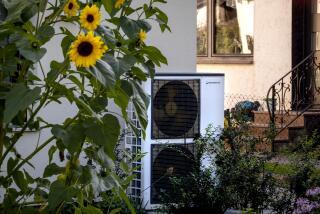Power up the ‘smart meters’
You don’t have to be a tinfoil-hat-wearing paranoiac to be worried that the electromagnetic radiation from modern wireless devices may be harmful to your health. But are the “smart meters” being installed by utilities throughout the state frying homeowners’ brains, as many consumers and even municipal governments fear? The risks are vanishingly small, while the economic and environmental benefits of smart meters are wide and obvious. In fact, we wish L.A.’s municipal utility would get busy installing the devices, though that isn’t likely to happen any time soon.
Smart meters have the potential to change the delivery of electricity as profoundly as the Internet changed the delivery of information.They contain radio transmitters that send real-time information about power usage directly to utilities and consumers — and, in the future, to smart appliances. This boosts efficiency in myriad ways.
Utilities save money because they no longer have to employ meter readers. Smart meters will also eventually enable utilities to raise and lower the price of electricity based on demand, allowing consumers to adjust their power use accordingly. So, for example, on hot summer days when power demand is high, consumers would save money by waiting until evening to run the dishwasher. If this causes them to reduce their overall usage, it should also lower their bills. Someday, smart air conditioners might be programmed to respond to these signals as well, turning themselves down when the price of power soars. The nationwide “smart grid” enabled in part by smart meters would cut the risk of blackouts, ease the integration of clean power sources such as wind farms and solar plants (these are tough to accommodate on the current grid because they produce power intermittently and the old-fashioned system can’t quickly react to changes in output), and reduce the need to build polluting fossil fuel power plants. Everybody wins.
Well, everybody except the exceptionally health-conscious. A program to install smart meters by the Northern California utility Pacific Gas & Electric has sparked a backlash among homeowners worried about the electromagnetic radiation emitted by the devices. They’ve found a receptive ear in such cities as Fairfax, Monterey, Capitola and Watsonville, which have approved moratoriums on smart meters. PG&E, which answers to the California Public Utilities Commission rather than to municipal governments, is rightly ignoring these nonsensical bans, though it plans to allow customers the option of keeping their analog meters in exchange for a monthly fee to cover the cost of sending a PG&E employee to read the old-fashioned devices.
Smart meters have been installed all over the country without raising a comparable fuss, and it’s likely that the Bay Area brouhaha is more a function of distrust than a rational response to danger. PG&E is among the nation’s more disliked utilities, thanks in part to its ill-advised forays into state politics and its poor handling of last year’s gas pipeline explosion in San Bruno that killed eight people and leveled dozens of houses. And it did a rotten job of explaining to its customers how the new meters could benefit them. But is there any justification for the health fears?
Not much. Radio waves put out heat, and extreme exposure to such heat has been shown to cause lab rats to lose their appetites. But the heat from smart meters is a “very small fraction of the exposure level established as safe” by Federal Communications Commission guidelines, according to a study released in April by the California Council on Science and Technology. The non-thermal effects of radio waves on human health are less understood; to date, scientists haven’t conclusively shown that there are any, but they haven’t proved there aren’t either. Yet most people are exposed to far more electromagnetic radiation from such everyday devices as cellphones and microwave ovens than they would be from a home smart meter. It’s another in a host of wireless devices, including garage door openers, cordless phones and wireless routers, that have become nearly ubiquitous.
Resistance to smart meters is mostly a Northern California phenomenon, though Times staff writer Melanie Hicken reported last month that a small group of residents in Burbank and Glendale is protesting installations by municipal utilities in those cities. We suspect the local outcry would be louder if the Los Angeles Department of Water and Power, which is nearly as unpopular among Angelenos as PG&E is among Northerners, were rolling out smart meters for residential customers more quickly. It has barely started, and as with other DWP initiatives to modernize its grid or invest in more renewable power, there is more talk about smart meters than action. Given that the devices would result in layoffs of meter readers, and that the electricians union holds enormous sway over DWP initiatives, plans are likely to remain on the drawing board for quite some time.
Though that may head off a smart meter controversy, L.A.’s dirty, antiquated and inefficient power system is nothing for Angelenos or DWP leaders to be proud of.
More to Read
A cure for the common opinion
Get thought-provoking perspectives with our weekly newsletter.
You may occasionally receive promotional content from the Los Angeles Times.






